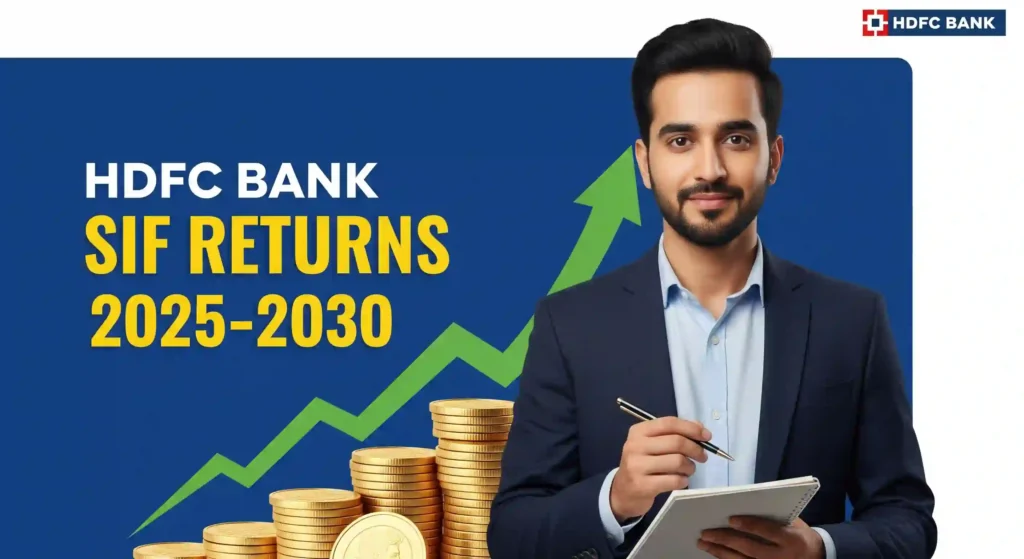As the Indian investment landscape evolves with SEBI’s new Specialized Investment Fund (SIF) framework, HDFC Bank’s wealth management arm is positioned to be a key player. This article offers a forward-looking, data-backed analysis of the expected returns and investment strategies of HDFC Bank’s SIFs from 2025 to 2030, helping sophisticated investors understand their potential for long-term portfolio growth.
HDFC Bank’s SIF Strategy: Capitalizing on the Next-Gen Market
HDFC Bank’s approach to Specialized Investment Funds in India is rooted in its deep understanding of high-net-worth (HNI) client behavior and its track record in delivering above-benchmark results in private wealth products.
The bank’s SIF investment strategies are designed to:
- Target niche opportunities often inaccessible to retail mutual funds, including private equity-linked debt, thematic equity plays, and real asset exposure.
- Use derivatives for tactical hedging and portfolio optimization within SEBI’s prescribed leverage limits.
- Implement dynamic asset allocation, allowing fund managers to shift between equities, fixed income, commodities, and alternatives based on market cycles.
- Leverage HDFC Bank wealth management research capabilities, drawing on proprietary models and macroeconomic forecasting to identify alpha-generating ideas.
The target investor base is predominantly HNIs, family offices, and ultra-high-net-worth individuals (UHNIs) seeking institutional-grade portfolio management with a multi-year commitment.
Projected SIF Performance: The 2025-2030 Outlook
While official HDFC Bank SIF returns 2025-2030 will unfold over time, forward-looking analysis can be built on HDFC Bank’s historical performance in alternative asset mandates and its published SIF strategy documents. These projections are hypothetical and assume stable macroeconomic growth, moderate inflation, and disciplined portfolio rebalancing.
| Scheme Name | Expected CAGR (2025-2030) | Target Asset Class | Key Risk Indicators | Minimum Investment |
|---|---|---|---|---|
| HDFC Multi-Strategy SIF | 11.2% | Equity + Alternatives | Drawdown: -7.5%, Beta: 0.68 | ₹1 crore |
| HDFC Strategic Debt SIF | 8.5% | Debt + Structured Credit | Drawdown: -3.2%, Beta: 0.25 | ₹1 crore |
| HDFC Thematic Growth SIF | 12.6% | Sector-Focused Equity | Drawdown: -9.1%, Beta: 0.82 | ₹1 crore |
| HDFC Balanced Advantage SIF | 9.7% | Dynamic Equity-Debt Mix | Drawdown: -5.0%, Beta: 0.55 | ₹1 crore |
Methodology:
The expected CAGRs are derived from back-testing similar mandates HDFC Bank has managed in PMS and AIF structures, adjusting for SEBI SIF regulations that allow greater flexibility than traditional mutual funds. Assumptions factor in alpha generation potential, reduced transaction friction due to institutional scale, and diversification benefits from multi-asset exposure.
💡 Pro Tip:
HDFC Bank SIFs are designed for a long-term investment horizon (3–5 years or more). Their ability to generate superior returns is tied to their flexible mandate, which requires patience from the investor to ride out short-term market volatility.
Navigating the Risks: SEBI’s Role & HDFC Bank’s Framework
SEBI SIF regulations aim to balance flexibility for managers with protection for investors. Key aspects include:
- Minimum Investment Threshold: ₹1 crore, ensuring only qualified investors participate.
- Risk Disclosure Mandates: Funds must publish metrics such as drawdown (the maximum peak-to-trough decline during a period) and beta to benchmark volatility.
- Leverage Controls: Use of derivatives is permitted for hedging and tactical allocation, but must remain within defined exposure limits.
HDFC Bank complements SEBI oversight with an internal governance framework that includes:
- Quarterly Performance Audits by independent risk teams.
- Scenario Testing to evaluate fund resilience in adverse market conditions.
- Risk-Adjusted Return Monitoring—measuring performance relative to volatility, ensuring strategies don’t chase returns at the cost of disproportionate risk.
Risk-Adjusted Return simply means: how much return you get for each unit of risk you take. For example, two funds may both return 10% annually, but the one with lower volatility offers a better risk-adjusted return.
Why HDFC Bank SIF Returns Matter for Long-Term Portfolios
From 2025 to 2030, Specialized Investment Fund India products like those from HDFC Bank may fill a gap between traditional mutual funds and private equity. They provide:
- Broader investment mandates.
- Higher alpha potential through active and tactical strategies.
- Customization for HNI needs.
Given their design, HDFC Bank SIF returns 2025-2030 could appeal to investors seeking both diversification and institutional-grade portfolio construction, provided they understand the liquidity and risk considerations.
FAQ
Q1: How are HDFC Bank’s SIFs different from their mutual funds?
SIFs have fewer investment restrictions, allowing broader asset class exposure, derivatives use, and tactical positioning not available to regular mutual funds.
Q2: What is the tax implication of SIF returns?
Taxation depends on the underlying assets. Equity-heavy SIFs may be taxed like equity funds, while debt-heavy SIFs follow debt fund capital gains rules.
Q3: Is an HDFC Bank SIF a suitable replacement for a PMS?
Not necessarily. While both target HNIs, SIFs offer more strategy flexibility and asset class diversity, whereas PMS products are typically equity- or debt-focused.
Final Thoughts
Ready to explore the next level of wealth management?
HDFC Bank’s Specialized Investment Funds offer a pathway to institutional-grade strategies under a regulated, transparent framework. The 2025-2030 horizon may prove rewarding for investors who can commit capital and remain patient through market cycles.
Connect with an HDFC Bank Wealth Relationship Manager to understand if a long-term SIF allocation fits your portfolio goals for 2025 and beyond.
This post is for informational purposes only.Invest responsibly.No guarantees of results. Seek professional guidance before investing.Consult experts for personalized advice.AI-assisted content, editorially reviewed.See our terms for details.Please note that I am not a SEBI registered investment advisor. The information provided in this article is for informational and educational purposes only and should not be construed as financial advice. Always consult with a qualified and SEBI registered financial professional before making any investment decisions. .Follows Google policies.Not affiliated with Investopedia.com. investopedia.co.in Independent site.
